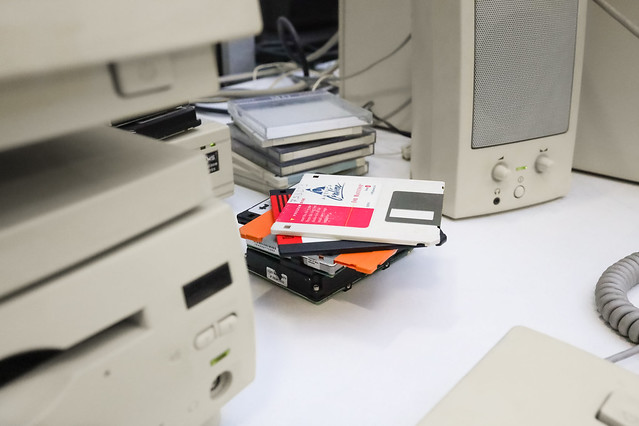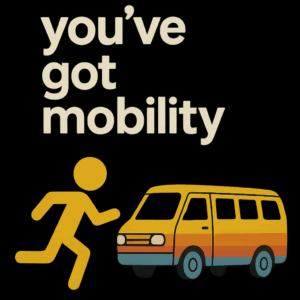A revolution is happening today with mobility data – and it’s essential for building equitable, sustainable transport systems around the world. To understand what’s wrong with transport data today – and how Trufi and others are working to fix it – let’s look at something else that once held back the future: your mom’s 1990 AOL account.
The Walled Gardens of the Early Corporate Internet
Note: If your proverbial mom was not in the USA, let AOL be a stand in for other early and limited online services such as BTX in Germany; Chollian in South Korea; Minitel in France; Nifty Serve in Japan; Prestel in the U.K.; Telefónica’s Videotex in Spain; or UOL in Brazil.
Your mom got a new computer. Also an AOL floppy disk came in the mail. So she signed up.
She was eager to chat with her best friend from college who lives across the country. But there’s a problem: her best friend used Prodigy, not AOL. What does this have to do with transport data? We’ll get there.
Back in the 1990s, platforms like AOL, Prodigy, and CompuServe trapped users inside “walled gardens” – closed systems that stifled connection and innovation. Unlike the real internet, which was used by researchers, universities, and free-range geeks, these corporate-controlled networks restricted users to stay within their ecosystems. AOL, Prodigy, and CompuServe users were all isolated from one another — none could communicate across platforms. All of these services had something like email and instant messaging, but they only worked between subscribers of the specific service.
The results of walled gardens stifled innovation and limited connectivity.
Hackers and Workaround Culture Weakened the Walls
When these corporations were controlling what their users could do and see, tinkerers and hackers built or found backdoors. Users and developers who knew what they were missing rigged workarounds to poke holes through proprietary garden walls.
- Users discovered that adding
@internetto an address (AOL) orINTERNET:(CompuServe) let them email people outside the platform – years before either of these companies officially supported it. - Users on all of these closed systems used a trick to access the wider internet by emailing special servers that returned web pages or shared files via email.
And the Walls Came Down
One by one, the corporate services realized their users were getting wise to and dissatisfied by the limits they imposed. So they retooled their systems and adopted the open standards of the internet – standards with names you may have heard, such as TCP/IP, HTTP, and SMTP.
These open standards unleashed the free-flowing exchange of information that powers today’s internet. By 1995, AOL, CompuServe, and Prodigy were giving all of their users access to the open internet.
Social Media’s Interoperability Efforts – Happening Now
Honest: We’ll get to transport data shortly. But if the previous example sounds like ancient history, here’s a topical example happening in real time, and you probably are in the thick of it.
Social media users today are stuck in walled gardens like 1990s AOL: you can’t leave Twitter (now rebranded as X; hereafter referred to as ‘Xitter’) without losing followers, and you can’t message Threads friends from Bluesky. The problem isn’t technology – it’s closed systems refusing to interoperate.
There are open protocols available to all of the social networks, should the tech corporations choose to open their gates. A protocol called ActivityPub could let Threads users follow Bluesky accounts, or allow LinkedIn posts to appear in your Facebook feed. You would be able to choose one preferred platform and interact with every other platform that embraces ActivityPub. You could switch platforms and take all of your friends and followers with you – regardless of their preferred platforms. Mastodon users already experience this freedom. The only thing missing is for the big platforms to tear down their walls and join the conversation. They could do it tomorrow if they wanted to.

Collage: Cory Doctorow (CC-BY-SA 2.0)
Workarounds and Duct Tape in Social Media
Just as early internet hackers breached walled gardens, today’s users are forcing interoperability – whether platforms like it or not. Bridges like Fed.Brid.gy let Mastodon and Bluesky users connect across protocols, while Threads’ has a half-hearted Mastodon ‘integration’ (follows work, likes are anonymous, replies vanish) which proves even reluctant giants feel pressure to open up.
And the demand is undeniable: millions use cross-posting tools like Buffer and Hootsuite, not because they’re seamless – they’re duct-tape solutions – but because people refuse to be siloed. Users will find ways around fragmentation. But they shouldn’t have to.
Baby Steps Towards Social Interoperability
Bluesky and Threads are tentatively testing interoperability – Threads with its half-implemented link to Mastodon, Bluesky with its own self-serving open protocol. Their nervous baby steps hint at a future where, like email, you could be able to follow friends across platforms without losing your community.
(Xitter remains the exception, doubling down on isolation – a relic of the walled-garden past.)
This isn’t just about social media. The same impulse to trap users – whether followers on apps or riders needing bus routes – prioritizes control over connection. When ownership matters more than people’s freedom to move or connect, people route around the barriers anyway.
The Walled Gardens of Transport Data
At last, let’s apply these lessons to transportation data.
Today, proprietary transport data creates real barriers to equitable, sustainable mobility. Informal transport networks – essential to billions in the global South – are often invisible to planners and apps, dismissed as chaotic rather than respected as vital.
As with the early internet and today’s corporate social media, innovation is stifled.
The reasons vary. Some agencies and companies want to monetize their data. Others fear that crowdsourced digital maps of informal networks will outshine their official maps. And some simply want to maintain control, arguing that informal transport is unsafe or unsavory and shouldn’t be encouraged.
Meanwhile, they’re often happy to consume open data, while giving nothing back.
Apps like Moovit and Citymapper make it easy to get around by pulling in transit data from many sources. Moovit even boasts that it uses crowdsourced open data for the London Underground (TfL). But Moovit rarely or never contributes to open data repositories. Citymapper, similarly publishes a long list of data sources it consumes, but if you want to use their data, you’ll find it behind a paywall.
Some agencies lock up their digitized transport data (GTFS feeds), or they partner with private platforms while excluding the public. Even where informal fleets are GPS-tracked, the data often stays with fleet managers or tech firms – not shared with communities, researchers, or planners.

Photo: Public Domain
Even tech giant Google depends heavily on open transport data through their Transit Partner Program — but while they build powerful features on top of that data, they rarely share enhancements, corrections, or real-time feeds back with the public or developer community. This approach benefits users of Google’s services but doesn’t contribute to the broader open data ecosystem.
And it’s not just governments and major tech companies being possessive about their transport data. In the global South, private minibus fleets, such as matatus in Kenya or jeepneys in the Philippines, have increasingly adopted GPS and Automatic Vehicle Location (AVL) technologies to monitor and manage their operations. However, this data is typically held by private companies and is not readily accessible to public agencies or researchers, limiting its potential impact on broader transport system improvements.
Fixing the Map the Authorities Said Wasn’t Broken
As with the tinkerers who breached the walls of AOL, CompuServe, and Prodigy; and as with today’s advocates building bridges between BlueSky and Mastodon, open data advocates in transport are breaking through closed systems – often with little or no funding, but with a lot of determination.
- MobilityDatabase: Compiled and validated by MobilityData, this open repository consolidates GTFS feeds from around the world – including those scraped or converted from closed systems – and makes them freely available to researchers, developers, and planners.
- Trufi Association: Trufi creates GTFS by extracting and processing informal transport data contributed to OpenStreetMap (OSM). To ensure high data quality, we also offer a free training course that equips local communities to map their networks accurately. The results are open, community-owned, and locally relevant.
- DigitalTransport4Africa (DT4A): A collaborative initiative that supports local groups in mapping informal transit across African cities. In many places where official data doesn’t exist, these grassroots efforts have produced the only GTFS feeds available in those cities.
- GTFS scraping tools: Developers use tools like cURL, custom scripts, and Python libraries to extract schedule and route data from agency websites or proprietary APIs (a process known as “scraping,” where data is collected from websites or systems that may not openly provide it). They then convert this data into GTFS for broader use.
These aren’t just technical hacks – they’re acts of data justice. By converting invisible, locked, or neglected transport systems into open data, these efforts empower cities, inform riders, and invite innovation that works from the ground up.
Not everyone took the open route. WhereIsMyTransport was a well-funded private company that also mapped informal networks in the global South. But they kept the data proprietary. Despite their impressive data set, the company shut down in 2023. Their story is a cautionary tale: when data stays locked up, it becomes fragile and ultimately irrelevant.
From ‘You’ve Got Mail’ to You’ve Got Mobility
Open transport data empowers local solutions, invites local knowledge, fosters innovation, and ensures everyone has access to sustainable transport options.
As open standards for transport data are spreading, the landscape is changing. More cities are embracing the idea that transport data should be public infrastructure – not a private asset. Informal networks are being digitized by communities, stored in open repositories, and woven into global apps. What once was invisible – the shared taxi, the informal bus, the unmarked minivan – is becoming mappable, analyzable, and fundable.
When transport data is open, the benefits ripple outward. Developers build smarter routing apps that work even in cities overlooked by mainstream platforms. Startups create hyper-local mobility services. Researchers use open data to reveal gaps in service, especially in underserved areas. And public transport becomes more discoverable and usable by the people who rely on it most – including low-income communities, women, and people with disabilities.
For cities, it means better planning with real-world data, not assumptions shaped by “car brain” thinking. It means rethinking mobility in terms of access, not traffic. For users, it means knowing which bus to take, which minivan is accessible, when it’s coming, and how to get where you’re going – without needing a car or a corporate app to mediate your trip. In short: open transport data gives people freedom of movement.
These efforts echo the transition from early Internet silos to open networks, showing how bridges between proprietary systems and open standards drive accessibility and innovation in mobility.
Why Trufi’s Approach Matters
What sets Trufi apart is our community-first methodology. Unlike corporate mapping efforts that extract and hoard data for profit, Trufi builds local capacity and ensures communities retain ownership of their transit knowledge. Our tools and training empower local communities to map, maintain, and improve their own transportation data – creating sustainable solutions that outlast any single project or app.
Transportation needs constantly evolve. When routes change or new services emerge, OSM communities with Trufi training can update their own data rather than waiting for corporate mappers or transport officials to care. The result is a living, breathing transit map maintained by the people who use it daily.
Open Ecosystems Win
The lesson never changes: open ecosystems win. AOL’s walled garden collapsed when users – perhaps your mom among them – demanded the full internet. Today, social media’s half-open platforms face the same pressure. With transport the stakes are higher – because locked data doesn’t just stifle innovation; it locks people out.
The corporate suits are playing a strategy called “disruption management.” They are clinging to closed systems knowing it will inevitably become a losing game. They will resist change until the moment resistance becomes unprofitable. The smart ones – the prescient ones – embrace the change just before their competitors (also playing the game) leapfrog them by doing it first.
Organizations like Trufi follow a different philosophy – NGOs, open data champions, sustainable transport advocates – we have been pushing for justice, for innovation, for disruption from the beginning.
Thanks to Isabelle de Robert of MobiiityData who reviewed this before publication.
Support Open Transport Data
If you support open transport data, consider a donation to Trufi Association
You can also Sponsor Trufi Association as an individual or company



Pingback: weeklyOSM 770 – weekly – semanario – hebdo – 週刊 – týdeník – Wochennotiz – 주간 – tygodnik